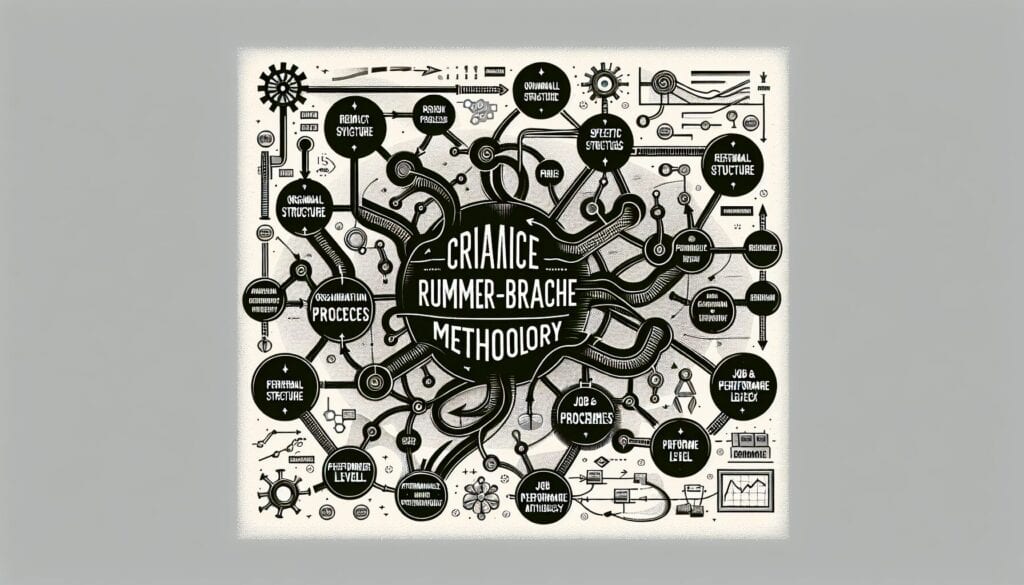Eine Methode zur Leistungsverbesserung, die sich darauf konzentriert, eine Organisation als adaptives System zu betrachten und die Leistung auf drei Ebenen zu managen: Organisation, Prozess und Job/Performer.
- Methodologien: Kunden & Marketing, Wirtschaft
Rummler-Brache-Methodik

Rummler-Brache-Methodik
- Agile Methodik, Geschäftsprozess-Reengineering (BPR), Änderungsmanagement, Kontinuierliche Verbesserung, Schlanke Fertigung, Organisatorische Transformation, Leistungsverfolgung, Prozessabbildung, Qualitätsmanagement
Zielsetzung:
Wie es verwendet wird:
- Der Schwerpunkt liegt auf dem Verständnis des "weißen Raums" zwischen den funktionalen Silos, in dem Prozesse oft zusammenbrechen. Nutzt Werkzeuge wie Prozess-Mapping und Human Performance System-Analyse zur Diagnose und Verbesserung der Leistung.
Vorteile
- Bietet einen umfassenden Rahmen für die Leistungsverbesserung; verknüpft Strategie, Prozesse und individuelle Leistung; hilft, systemische Probleme zu erkennen und anzugehen.
Nachteile
- Kann komplex sein, um vollständig umgesetzt zu werden; erfordert einen systemorientierten Ansatz in der gesamten Organisation; kann erhebliche Schulungen und kulturelle Veränderungen erfordern.
Kategorien:
- Personalwesen, Projektmanagement, Qualität
Am besten geeignet für:
- Verbesserung der Unternehmensleistung durch systematische Analyse und Abstimmung von Zielen, Prozessen und individueller Arbeitsleistung im gesamten Unternehmen.
The Rummler-Brache Methodology is particularly effective in industries such as healthcare, manufacturing, finance, and technology, where process efficiency is pivotal for organizational success. During the planning and execution phases of projects, this methodology can be initiated by executives or operations managers looking to enhance alignment between strategic objectives and day-to-day operations. Participants generally include cross-functional teams composed of stakeholders from different areas of the organization, as it promotes collaboration and communication among various departments. Tools used in this methodology, such as process mapping, allow for visual representation of workflows, making it easier to identify bottlenecks and areas for improvement. Human Performance System analysis further aids in diagnosing problems by examining how individual behaviors impact overall performance. This systematic approach not only targets existing issues but also ensures that future initiatives are aligned with the organization’s long-term goals. The framework supports continuous improvement efforts, fostering a culture where feedback is integrated into performance reviews and project evaluations, thus encouraging adaptive strategies that can be implemented in real-time. As such, organizations employing this methodology often report enhanced employee engagement and accountability, as individuals understand how their performance directly influences organizational success.
Die wichtigsten Schritte dieser Methodik
- Identify the organizational goals and objectives.
- Map current processes across functional silos.
- Analyze the "white space" between processes for performance breakdowns.
- Assess individual job performance related to processes.
- Identify systemic issues affecting organizational performance.
- Develop interventions targeting the identified issues.
- Implement process improvements and training initiatives.
- Monitor performance changes and adjust as necessary.
Profi-Tipps
- Conduct regular cross-functional reviews to surface hidden inefficiencies and align goals across silos.
- Utilize data analytics to identify performance gaps and quantify the impact of process changes on outcomes.
- Develop a culture of continuous feedback and open communication to mitigate resistance to change and enhance collaboration.
Verschiedene Methoden lesen und vergleichen, Wir empfehlen die
> Umfassendes Methoden-Repository <
zusammen mit den über 400 anderen Methoden.
Ihre Kommentare zu dieser Methodik oder zusätzliche Informationen sind willkommen auf der Kommentarbereich unten ↓ , sowie alle ingenieursbezogenen Ideen oder Links.
Historischer Kontext
1962
1970
1972
1980
1980
1986
1986
1960
1963
1970
1980
1980
1980
1986
1987
(wenn das Datum nicht bekannt oder nicht relevant ist, z. B. "Strömungsmechanik", wird eine gerundete Schätzung des bemerkenswerten Erscheinens angegeben)















Verwandte Artikel
Management der Produktionsabläufe (MOM)
Fertigungsausführungssystem (MES)
Produktionslenkungsplan
Manuelle Prüfung
Bewertungsbögen für die manuelle Handhabung (MAC)
ManTRA (Instrument zur Risikobewertung manueller Tätigkeiten)